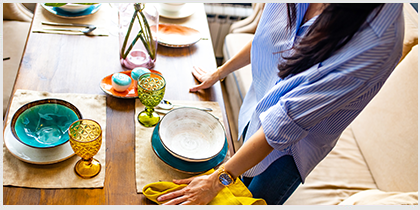Learning objectives: After reading this Information Sheet, You must be able to learn and understand about table etiquette.
Etiquette is a set of rules which govern the serving and eating of a meal; the strictness with which they are adhered to depends on the degree of formality of the meal, lunch generally being less formal than dinner. The guest’s enjoyment will be increased if a tasteful arrangement of the table and a flawless service are added to the good quality of the food.
Basic Table Etiquette:
- Sit down and rise from the left side of the chair, Do not begin conversation at table until after grace is said, carry-on conversation in a low, well modulated voice. Avoid arguments and unpleasant topics.
- Adopt the host’s/hostess method whenever in doubt as what to do.
- Do not fold your napkin at the end of the meal but place it loosely beside the plate.
- Wait all those at table are served before you begin to eat, unless the group is large.
- Do not use bread to wipe the last bit of gravy or sauce.
- Do not tip a dish to obtain the last portion of the food
- Do not blow on food to cool.
- Eat slowly and quietly, never talk with food on the mouth, take small bite
- Take care to finish a course at about the same time as the others at the table.
- Place the silver on the dish to which it belong, keep the table cloth as clean as possible. Do not lay used silver on the tablecloth
- Break bread into small pieces
- Pass food as a general rule to the right.
- Do not reach in front of a person to get a dish rather ask to have it passed.
- Do not leave the table without being excused.
- Do not use toothpicks while at the table.
- Pick-up the napkin with your left hand when you see your host doing so.
- If you don’t know what you’re eating, don’t be shy to ask, you are not expected to know everything.
- If you don’t like what you are eating, don’t be shy to spit it, but do it conspicuously.
- As much as possible, keep your plate neat and tidy
- Do not eat from your neighbor’s plate. If you want to try his food, ask for a small piece and put it on your plate or a spare one.
- Some food items are eaten with your fingers, for which you will be given finger bowl.
- Dip your fingers on the finger bowl, but it is still best to simply excuse yourself and wash your hands in the rest room
- Eat Pizza the way you eat a sandwich by handling a slice between your fingers, nobody eats a sandwich or pizza by cutting it with your fork or knife.
- Glasses should not be removed until the very end of the meal
- To smoke during a meal are extremely bad manners and ashtrays should never be placed on the table
- When a course is over, the guest should leave his cutlery on his plate, side by side(never cross)
- The person who clears the table should remove the plate one by one, without stacking them up
- Use knife for cutting meat, lettuce or anything that does not cut easily with the fork, and for spreading butter or jelly.
- Use a fork eating a brick of ice cream, cake with sticky icing, jelly
- Use spoon dipping soup, tasting beverage, stirring beverages and soups, eating ice cream from a sherbet glass, eating pudding and cereals
- Use fingers for eating potato chips, relishes such as pickles and radishes, eating dry crisp bacon and cake which is not sticky, removing fish bones, small fruits pits or seeds of fresh fruits from the mouth, and for eating bread and crackers.
- Meat should be cut into three or four bite’s at a time. Knife and fork should be used for tougher meat, the edge of the fork for tender meat.
- Chicken should be cut off the bones with a knife, In every informal situation it may be picked up with the fingers delicately
- Fish is usually tender enough to cut with the edge of a fork, bones can be removed with the fingers and placed on the table.
- Corn on the cob should not appear on a very formal menu. It may already be buttered or can be buttered a few bites at a time. It can be pick-up with the fingers of one hand
- Salad should be eaten with a salad fork when serve as a separate course, If served with the main course, it may be eaten with dinner fork or fork salad
- Sandwiches may be picked up with the fingers unless hot or covered with gravy, large sandwiches may be broken with the fingers or cut w. the fingers or with knife, using the other hand to steady them.
- Fresh fruits served at the table may be quartered and peeled with the fruit knife provided, and eaten with the fingers. Bananas should be peeled down halfway, a small piece broken off, eaten one at a time with the fork
Avoid this:
- chewing with the mouth open or talking when the mouth is full
- Dipping bread in soup or coffee
- Stacking dishes after eating
- Crumbling crackers into the soup
- Resting elbows on the tables
- Buttering whole slices of bread all at once
- Eating with a knife
- Leaving a spoon in a cup or glass
- Sipping soup noisily
- Slumping on your chair
Basic Do’s and Don’ts
- Do put your napkin on your lap
- Do chew with your mouth closed
- Don’t slurp your soup
- Don’t laugh too loud
- Do not scratch yourself with your knife
- Never ever put fingers in your soup
- Do not throw your bones under the table or to lick your plate
- Do not burp! If you did say excuse me
Do n of fart! Excuse yourself from the table4 and do it elsewhere.





 (30 votes, average: 3.97 out of 5)
(30 votes, average: 3.97 out of 5)
No Comments